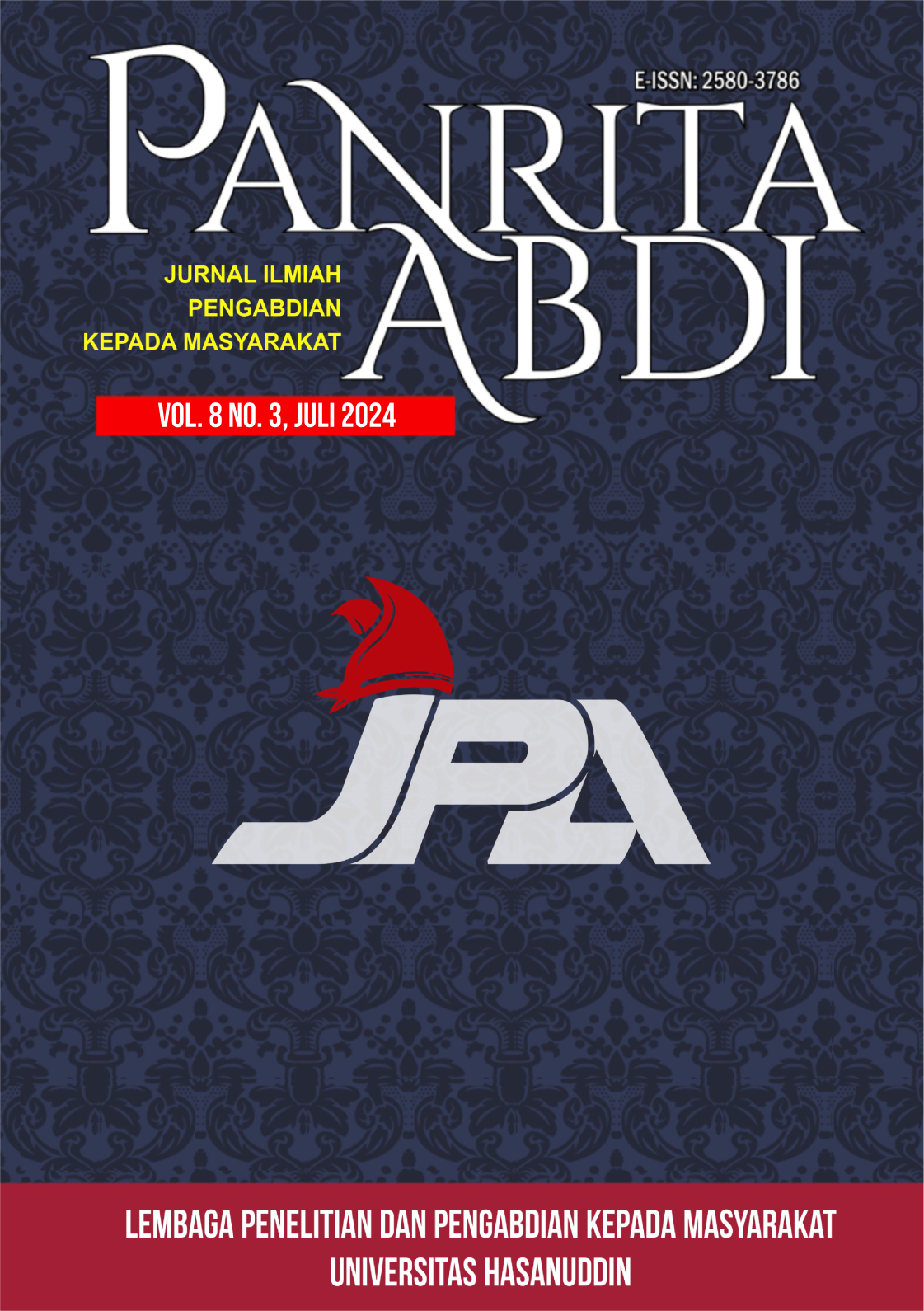PENDAMPINGAN PENGEMBANGAN MEDIA E-DAKWAH BERBASIS APLIKASI PERSONAL BROADCASTING DI MANDINGAN KEBONAGUNG YOGYAKARTA
DOI:
https://doi.org/10.20956/pa.v8i3.35082Keywords:
Assistance, e-dakwah media, broadcastingAbstract
The problem faced by society is that the media for conveying Islamic da'wah is less popular because it is too monotonous and uninteresting. Therefore, creativity is needed in packaging da'wah media to be more applicable and encourage people to practice directly using applications published on various digital media. So the lecture content must be interesting so that it attracts the attention of the millennial generation, one of the technologies used is Open Broadcaster Software (OBS). This service aims to solve the problem of ineffective delivery of Islamic risks. Apart from that, it also seeks to bring people closer to technology literacy. The service uses lecture and training methods as well as e-da'wah model assistance. The results of this service are sufficient to provide solutions to public problems. Delivering da'wah becomes more interesting with the OBS digital application. OBS is used as an effort to answer the challenges of da'wah in the current era. In addition, the OBS application-based da'wah media can speed up the da'wah message from the subject of the da'wah (dā'i) to the object of the da'wah (mad'ū). --- Problem yang dihadapi masyarakat adalah media penyampaian dakwah Islam yang kurang disukai karena terlalu monoton dan tidak menarik. Karena itu, perlu kreativitas dalam mengemas media dakwah agar lebih aplikatif dan mendorong masyarakat untuk praktek secara langsung dengan menggunakan aplikasi yang dipublikasikan di berbagai media digital. Maka konten ceramah harus menarik agar menjadi perhatian para generasi milineal, salah satu teknologi yang digunakan adalah Open Broadcaster Software (OBS). Pengabdian ini bertujuan untuk memberikan solusi terhadap masalah penyampaian risalah Islam yang kurang efektif. Selain itu, juga bertujuan untuk mendekatkan masyarakat agar melek teknologi. Pengabdian menggunakan metode ceramah dan pelatihan serta pendampingan model e-dakwah. Hasil pengabdian ini cukup memberikan solusi terhadap masalah keumatan. Penyampaian dakwah menjadi lebih menarik dengan aplikasi digital OBS. OBS yang digunakan sebagai usaha untuk bisa menjawab tantangan dakwah di era sekarang. Selain itu, media dakwah berbasis aplikasi OBS dapat mempercepat pesan dakwah dari subjek dakwah (dā’i) kepada objek dakwah (mad’ū).
References
Al-Mubākfūri, S. S. (2009). Sirah Nabawiyah. Al-Kautsar.
Audunson, R. A., & Shuva, N. Z. (2016). Digital Library Education in Europe: A Survey. SAGE Open, 6(1). https://doi.org/10.1177/2158244015622538
Bateman, J. A. (2021). What are digital media? Discourse, Context and Media, 41, 100502. https://doi.org/10.1016/j.dcm.2021.100502
Degner, M., Moser, S., & Lewalter, D. (2022). Digital media in institutional informal learning places: A systematic literature review. Computers and Education Open, 3(December 2021), 100068. https://doi.org/10.1016/j.caeo.2021.100068
Fakhruroji, M. (2015). Mediatization of religion in “texting culture”: self-help religion and the shifting of religious authority. Indonesian Journal of Islam and Muslim Societies, 5(2), 231. https://doi.org/10.18326/ijims.v5i2.231-254
Fantoni, G. (2023). The Revolution Will Be Televised: The Italian Communist Party, Public Television Broadcasting and the ‘Free Television’ Experiment. Contemporary European History, 32(3), 385–400. https://doi.org/10.1017/S0960777321000692
Hakim, A. R. (2024). Pelatihan Penggunaan Aplikasi Mobile Untuk Klasifikasi Metode Persalinan Pada Ibu Hamil. Jurnal Ilmiah Pengabdian Kepada Masyarakat, 8(2).
Meleong, L. J. (2017). Metodologi Penelitan Kualitatif. Remaja Rosdakarya.
Naggar, S. El. (2014). The impact of digitization on the religious sphere: televangelism as an example. Indonesian Journal of Islam and Muslim Societies, 4(2), 189–211.
Park, B., Plass, J. L., & Brünken, R. (2014). Cognitive and affective processes in multimedia learning. Learning and Instruction, 29, 125–127. https://doi.org/10.1016/j.learninstruc.2013.05.005
Qurtuby, S. Al, Darmadi, D., & Srimulyani, E. (2013). Islam, Media, and Social Responsibility in the Muslim World. Studia Islamika, 20(3).
Rahabav, P. (2023). Metode Penelitian Sosial Pedoman Praktis Penulisan Skripsi, Tesis dan Disertasi. Citra Media Nusantara.
Rohmansyah, R. (2018). Kuliah Kemuhammadiyahan. LP3M Universitas Muhammadiyah Yogyakarta.
Sanusi, B. O., Talabi, F. O., Adelabu, O. T., & Alade, M. (2021). Educational Radio Broadcasting and its Effectiveness on Adult Literacy in Lagos. SAGE Open, 11(2). https://doi.org/10.1177/21582440211016374
Tabroni, I., Husniyah, H., Sapitri, L., & Azzahra, Y. (2022). Impact of Technological Advancements on The Establishment of Characteristics of Children. EAJMR: East Asian Journal of Multidisciplinary Research, 1(1), 27–32. https://doi.org/10.54259/eajmr.v1i1.453.
Ummah, A. H. (2020). Dakwah Digital dan Generasi Milenial (Menelisik Strategi Dakwah Komunitas Arus Informasi Santri Nusantara). Tasâmuh, 18(1), 54–78. https://journal.uinmataram.ac.id/index.php/tasamuh/article/view/2151.
Downloads
Published
How to Cite
Issue
Section
License
Copyright (c) 2024 Rohmansyah, Talqis Nurdianto, Budi Jaya Putra

This work is licensed under a Creative Commons Attribution-NonCommercial-NoDerivatives 4.0 International License.











